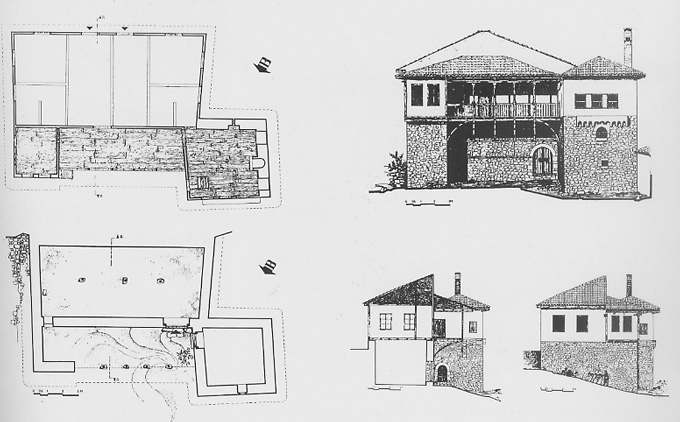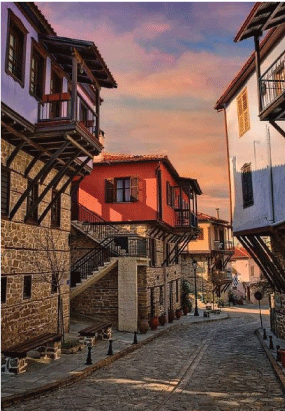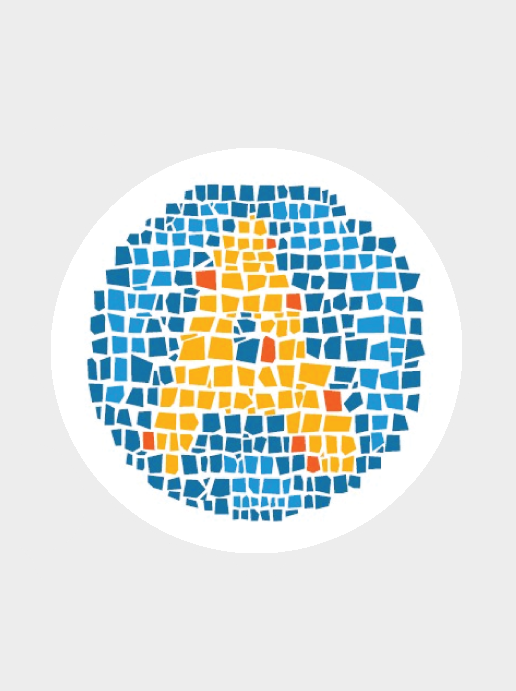Η Αρναία είναι ένας από τους πιο όμορφους ορεινούς οικισμούς της Χαλκιδικής με πληθυσμό 2.300 κατοίκους (Απογραφή 2011 – ΦΕΚ 3465 τεύχος Β / 28-12-2012). Είναι κτισμένη στους πρόποδες του όρους του Χολομώντα, σε υψόμετρο 600 μ. Απέχει περίπου 70 χλμ. από τη Θεσσαλονίκη και 38 χλμ. από τον Πολύγυρο. Διασχίζεται από την εθνική οδό 16 (Θεσσαλονίκης-Ιερισσού) που οδηγεί στο Aγιο Oρος. Αποτελεί έδρα της Ιεράς Μητροπόλεως Ιερισσού, Αγίου Ορους και Αδραμερίου.
Ο οικισμός είναι κτισμένος αμφιθεατρικά μέσα σε ένα καταπράσινο τοπίο με πλούσια δάση και άφθονα τρεχούμενα νερά. Οι μόνιμοι κάτοικοί της ασχολούνται με την υλοτομία, την κτηνοτροφία, την μελισσοκομία, αλλά και με τις τέχνες, τις επιστήμες και το εμπόριο. Η Αρναία διατηρεί ακόμη και σήμερα δείγματα μιας παλιάς τοπικής κοινωνίας όσον αφορά στον πολεοδομικό και αρχιτεκτονικό της χαρακτήρα. Ο οικισμός δεν αναπτύχθηκε πάνω σε κάποιον οργανωμένο προϋπάρχοντα ιστό. Είναι παλιός, χωρίς πολεοδομικό σχέδιο και πυκνοδομημένος. Σύμφωνα με την παράδοση, οι κάτοικοι που επέστρεψαν στην πόλη μετά την καταστροφή της από τους Τούρκους άρχισαν να ξαναχτίζουν τον οικισμό γύρω από τις πλατείες. Τα σπίτια είναι πολύ κοντά το ένα στο άλλο και χωρίς αυλές για να προφυλάσσονται με αυτόν τον τρόπο από τον αέρα και να διατηρούνται ζεστά κατά την διάρκεια του χειμώνα.
Δεν υπάρχουν ελεύθεροι χώροι μέσα στον οικοδομικό ιστό. Υπάρχουν στενά, πλακόστρωτα δρομάκια και πλατείες που συνθέτουν έναν ελκυστικό συνδυασμό της ομορφιάς του περιβάλλοντος χώρου και της παράδοσης. Ο πυρήνας του οικισμού είναι η κεντρική πλατεία, το «παζάρι», όπου υπάρχει ένας μεγάλος πλάτανος μέσα από τον οποίο κυλά πόσιμο νερό. Γύρω από την πλατεία και τον κεντρικό δρόμο, όπου είναι συγκεντρωμένες οι δημόσιες υπηρεσίες, οι τράπεζες, τα καταστήματα και οι χώροι εστίασης με τα παραδοσιακά καφενεία και τις ταβέρνες, αναπτύσσεται το εμπορικό κέντρο της Αρναίας.
Συνέχεια του καταστραφέντος κάστρου ήταν ένας νέος μικρός οικισμός που ιδρύθηκε σε κοντινή απόσταση στα τέλη του 15ου αιώνα με αρχές του 16ου αιώνα από εργάτες μοναχούς του μετοχίου της αγιορείτικης μονής Κωνσταμονίτου και έλαβε την ονομασία Λιαρίγκοβα ή Λιαρίγκοβη (από τις σλάβικες λέξεις λιέρα (κόπρος) και γκοβνή (σωρός), δηλαδή σωρός κόπρου, επειδή η πεδιάδα ήταν τόπος βοσκής ζώων της μονής Κωνσταμονίτου). Η πρώτη σαφώς χρονολογούμενη αναφορά της Λιαρίγκοβας ή Λιαρίγκοβης γίνεται σε ένα φερμάνιο του 1750, το οποίο περιλαμβάνει έναν κατάλογο των μετοχίων της μονής Κωνσταμονίτου του Αγίου Ορους.Ο οικισμός αυτός γνώρισε ιδιαίτερη άνθιση κατά τον 18ο αιώνα, λόγω της απασχόλησης των κατοίκων στα μεταλλεία των Σιδηροκαυσίων (Ολυμπιάδας-Στρατωνίου) στην Βόρεια Χαλκιδική και αποτέλεσε πρωτεύουσα της περίφημης μεταλλευτικής ομοσπονδίας των 12 Μαντεμοχωρίων (οι 12 κοινότητες των Μαντεμοχωρίων ήταν οι εξής: Γαλάτιστα, Ραβνά, Πετροκέρασα, Σταυρός, Βαρβάρα, Λιαρίγκοβη, Νοβοσέλο {Νεοχώρι}, Μαχαλάς {Στάγειρα}, Ισβορος {Στρατονίκη}, Χωρούδα, Ρεβενίκια {Μεγάλη Παναγιά} και Ιερισσός). Το 1775 η Πύλη δέχτηκε να παραχωρήσει την εκμετάλλευση των μεταλλείων στα Μαντεμοχώρια με τον όρο να αποδίδουν στο οθωμανικό κράτος ένα μέρος από την παραγωγή τους. Ετσι, κατά την διάρκεια της Τουρκοκρατίας συνέχισε να είναι ένα σημαντικό κέντρο της περιοχής της Χαλκιδικής με μεγάλη εμπορική κίνηση. Μάλιστα, ο Γάλλος πρόξενος στην Θεσσαλονίκη Cousinery, ο οποίος πέρασε από την Λιαρίγκοβη το 1793, την περιγράφει ως έναν αυτάρκη και δυναμικό οικισμό. Χαρακτηριστικά σημειώνει: «Η ευμάρεια, μέσα στην οποία ζουν οι κάτοικοι της Λιαρίγκοβης δεν προέρχεται μόνο από την καλλιέργεια των αγρών τους. Κατασκευάζουν τάπητες για τους οποίους χρησιμοποιούν το μαλλί του τόπου. Σχεδόν όλες οι οικογένειες ασχολούνται με την εργασία αυτή και τα προϊόντα της βιοτεχνίας έφθαναν και πωλούνταν ως τη Ρουμελία (Romelie) και ιδίως στα Μοναστήρια».
Πριν από την επανάσταση του 1821 αλλά και μετά, οι κάτοικοι ασχολούνταν εκτός από την υφαντική, με τη μελισσοκομία και το εμπόριο ξυλείας και ζώων. Το 1932 η Αρναία ήταν το πιο μεγάλο χωριό της Βόρειας Χαλκιδικής με 3.000 κατοίκους που ήταν έμποροι, μελισσουργοί, ξυλουργοί, αλλά και κατασκευαστές χειροποίητων παπουτσιών -υπήρχαν μάλιστα 50 συντεχνίες με πρωτομάστορες και καλφάδες. Η ομοσπονδία των Μαντεμοχωρίων διαλύθηκε με την έναρξη της επανάστασης του 1821, στην οποία συμμετείχε ενεργά και η Λιαρίγκοβη. Η επανάσταση στην περιοχή είχε άδοξο τέλος με αποτέλεσμα η Αρναία να αποτελέσει ένα από τα 42 χωριά της Χαλκιδικής που πυρπόλησε ο Μπαϊράμ πασάς και να ερημωθεί από τους κατοίκους της. Επανέρχονται αργότερα στον τόπο τους και αναμορφώνουν τον οικισμό, οπότε και απέκτησε σταδιακά τη μορφή που έχει σήμερα. Ο νέος οικισμός υπάγονταν στην δικαιοδοσία του Τούρκου Καδή της Θεσσαλονίκης.
Το 1854, όταν ξέσπασε η επανάσταση του Τσάμη στην Χαλκιδική η Λιαρίγκοβα δεν υπέστη νέες καταστροφές από τους Τούρκους. Κατά τον Μακεδονικό αγώνα των ετών 1904-1908 η Λιαρίγκοβα συμμετείχε έντονα με αρκετούς αγωνιστές. Στις 2 Νοεμβρίου του 1912 η πόλη απελευθερώθηκε επισήμως από τους Τούρκους.
Αξιόλογος είναι και ο σταυροειδής με τρούλο ναός των Αγίων Αναργύρων, του 1919, σε σχέδια του Αναστάσιου Ορλάνδου. Το 1924 μια συνοδεία μοναχών από το Αγιο Ορος αγιογράφησε το ναό στον οποίο γίνεται καθημερινά εσπερινός και όρθρος. Ενδιαφέρον παρουσιάζει και το επιβλητικό κτίσμα του δημοτικού σχολείου με το τεράστιο προαύλιο. Αποτελεί χαρακτηριστικό δείγμα σχολικής αρχιτεκτονικής της δεκαετίας του 1930.
Σ’ ολόκληρη την πόλη σώζεται ένας μεγάλος αριθμός παλαιών παραδοσιακών κατοικιών, σημαντικής αρχιτεκτονικής αξίας. Είναι κατασκευασμένες με βασικά υλικά την πέτρα και το ξύλο, από Αρβανίτες και Ηπειρώτες τεχνίτες -οι οποίοι στάθμευαν στην Αρναία καθώς πήγαιναν να εργαστούν στα μοναστήρια του Αθωνα-, αλλά και ντόπιους μάστορες. Τα παραδοσιακά σπίτια της Αρναίας είναι αντιπροσωπευτικοί τύποι της αρχιτεκτονικής της Βόρειας Χαλκιδικής. Πολλά από αυτά γκρεμίστηκαν μερικά ή ολικά και δεν είναι εφικτό να δοθεί μια αυστηρή τυπολογία της κατασκευής τους. Από αυτά που διατηρούνται μπορούμε να διακρίνουμε δύο κατηγορίες με βάση τον τύπο της κάτοψης του ορόφου και των μορφών των επιμέρους στοιχείων του συνόλου της κατασκευής.-Η πρώτη κατηγορία περιλαμβάνει κατοικίες που χτίστηκαν μετά την ολοκληρωτική καταστροφή του οικισμού από τους Τούρκους το 1821.
-Η δεύτερη κατηγορία περιλαμβάνει αυτές που χτίστηκαν μετά το 1850-60 έως το 1940-45.
Τα παλαιότερα σπίτια είναι συνήθως μονόχωρα, μονώροφα ή διώροφα με χαγιάτι στο μπροστινό μέρος, που ήταν ένας ημιυπαίθριος χώρος και στηριζόταν με αντηρίδες, και δωμάτιο στο πίσω τμήμα. Με το πέρασμα του χρόνου σταδιακά το χαγιάτι παύει να είναι ο λειτουργικός πυρήνας του αρναιώτικου σπιτιού και εμφανίζεται η σάλα να έχει τον πρωταρχικό ρόλο. Τα σπίτια χαρακτηρίζονται σε αυτή τη φάση από εσωστρέφεια και αποκτούν φρουριακό χαρακτήρα. Από μορφολογική άποψη υπάρχει ποικιλία των παραδοσιακών κατοικιών, η οποία αφενός οφείλεται στην πυκνή δόμηση που αναγκάζει τους τεχνίτες να επινοούν ιδιαίτερες λύσεις και αφετέρου στην εξέλιξη των εξωτερικών και εσωτερικών δομικών στοιχείων.
Οι κατοικίες αυτές, αναστηλωμένες σήμερα και σε αποχρώσεις του λουλακιού, της ώχρας και του κεραμιδί, μαρτυρούν την ευμάρεια που γνώρισε η Αρναία στο παρελθόν. Με τη λεπτότητα και τη χάρη της κατασκευής τους, με τη χαρακτηριστική πέτρινη διακόσμηση, τα περίτεχνα θυρώματα, τα χαγιάτια και την μεγάλη ποικιλία παραθύρων, χάρισαν στην Αρναία μια μοναδική αρχοντιά. Η ύπαρξη του «ζωντανού» αυτού παλαϊκού ιστού αιτιολογεί απόλυτα τον επίσημο χαρακτηρισμό της Αρναίας το 1987 από το Υπουργείο Πολιτισμού ως «Ιστορικό τόπο» και «Παραδοσιακό οικισμό». Ολα παρέμειναν στην θέση τους, κάποια άλλαξαν χρήση, τα κτίρια όμως της Αρναίας διατήρησαν την παλιά παραδοσιακή αρχιτεκτονική τους μορφή παραμένοντας αιώνιοι μάρτυρες της λαμπρής ιστορικής της διαδρομής.

Με τη βοήθεια του Δήμου, της IV Εφορείας Νεοτέρων Μνημείων και διαφόρων προγραμμάτων έγιναν αναστηλώσεις και αποκαταστάσεις σε αρκετά κτίρια με αποτέλεσμα η Αρναία να διαθέτει σήμερα μια πλειάδα κτιρίων που έχουν χαρακτηριστεί ως διατηρητέα-έργα τέχνης και κάποια ως παραδοσιακά. Ολα αυτά τα στοιχεία δημιουργούν μια νοσταλγική διάθεση στον επισκέπτη αλλά και στον ερευνητή που θα έρθει να μελετήσει την πλούσια ιστορική και λαογραφική παράδοσή της. Συμβάλλουν στο να κατανοήσει το κλίμα μέσα στο οποίο αναπτύχθηκε και εξελίχθηκε η τοπική κοινωνία στο πέρασμα του χρόνου. Συνάμα η σπάνια φυσική και αισθητική ομορφιά του περιβάλλοντος χώρου με τις εναλλαγές των τοπίων και τις μοναδικές περιηγητικές διαδρομές στον Χολομώντα αποτελούν μια έξοχη πρόταση για κάθε επισκέπτη που αναζητά έναν γαλήνιο προορισμό.
* Ευχαριστούμε την αρχαιολόγο κα Αθηνά Μαραθιανού για τα κείμενα που μας παραχώρησε.
ΤΟ ΑΡΘΡΟ




